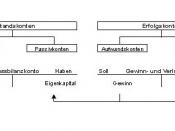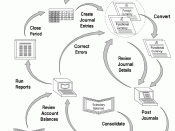Within the SMDC Finance department, it is the job of Accountants to gather the information necessary to deliver a complete, timely and accurate picture of the financial well being of the organization. SMDC is a large organization which consists of 3 hospitals and over 15 clinics in 3 states. Information from many areas different automated systems is needed to complete the accounting cycle. Some of these areas and systems will be discussed in this paper.
The first area that will be discussed is the Business Services departments, which include Accounts Receivable, Charge Entry, Coding, Reimbursement, Payment Posting and Customer Service. The Business Services department maintains the accounts receivable. The Accounts Receivable systems include Epic for the clinical areas and HBOC for the hospital areas. The majority of revenue and cash received within our organization is processed through the different accounts receivable systems. Through daily postings, the business services departments are responsible for posting of charges or revenue, billing these charges to insurance companies or guarantors, and posting payment and adjustments that are received from payers and patients.
All of these entries are maintained within the accounts receivables systems and then electronically fed into the general ledger at month end.
The second area that is will be discussed in the accounting cycle is the Materials Management and the Accounts Payable areas. Whereas, Accounts Receivable has the task of managing the charges and payments coming into the system, Materials Management and Accounts Payable hold responsibility for maintaining inventory for the organization and making sure the bills get paid for the organization. Materials Managements maintains inventory for the organization. It is the responsibility of this department to maintain accurate inventory levels to adequately stock the organization with supplies and other items that are needed by the different departments. Materials Management and Accounts Payable work closely together. Materials Management is charged with the ordering of supplies and other items and maintaining the invoices for these different purchases. After this has been completed, Accounts Payable steps in and makes sure these invoices are paid in a timely manner. At month end, electronic feeds from these areas are fed into the general ledger. These are the main areas that will feed into expense accounts, inventory accounts, payables and cash accounts.
Another area that is integral to the accounting cycle is the Payroll department. The Payroll department is responsible for gathering the information it needs to maintain the Payroll system which includes wages and salaries, benefits, taxes, and voluntary deductions such as health, dental, and life insurance and also such items like 403B deductions. The Payroll area is charged with the responsibility of accurately and timely paying of all employees, including physicians. This is a very integral aspect of the accounting cycle to both the employees and the employer. This is also an automated system that is maintained each month by employees and then fed electronically to the general ledger each month. The general ledger receives enormous amounts of information from the payroll system each month including salaries and benefits expense and payables, taxes expenses and payables, voluntary deductions expenses and payables and cash payment from the system.
In healthcare there are also vast amounts of major equipment or capital projects that must be bought, maintained, depreciated and tracked. For this purpose, SMDC maintains another system for the previously mentioned processes. This system is called the fixed assets system. This is a system which tracks the purchases, life expectancies and the depreciation expense that is associated with all capital items. At month end, this system feeds information into the general ledger that includes depreciation expense, works in process, and capital inventory and purchases.
The last information system that will be discussed as an aid in the accounting cycle is the TSI system. The TSI system is an integrated system that received information from the accounts receivable systems, purchasing systems, payroll systems and other areas that help maintain our total cost accounting processes. This system allows for the direct tracking of costs that are related to each department within the organization. This system allows for Accountants and Analysts to analyze cost data and accurately process the allocation of indirect costs. Within the organization, all revenue producing department like cardiology and internal medicine need to receive a portion of the costs associated with non revenue producing departments like Finance, IS, and the Business Services Departments. Although department like cardiology are focused on the day to day patient care, they would not be able to be in business without the daily work of the Finance, IS, and Business Services departments. For this reason, they must be charged with the expenses relating to the work of these non-revenue producing departments. The TSI system helps generate the information to allow Finance to accurately charge these costs to these departments.
Although electronic systems and feeds to the general ledger are a large piece of the process to the accounting cycle at SMDC, there are large amounts of data that must be entered manually. Such items like retail receipts from pharmacies and optical shops, bank reconciliations, wire transfers, budget information and accruals and adjustments are needed to maintain the accurate financial picture. Although most processes are done through electronic systems within SMDC, many of the above items are still maintained manually and must be completed through journal entries.
SMDC is a large and complex organization. The financial statements that are provided to show the financial picture of the organization are only completed at the end of the accounting cycle. This cycle is highly evolved through the use of integrated automated systems, but also still relies on the input of manual journal entries. Without the involvement of the Business Services department, Payroll department, Materials Management and Accounts Payable departments, the TSI system analysts, and the numerous accountants and analysts that gather and verify these systems along with the manual entries that are needed, a true and accurate financial picture of SMDC could not be shown.


